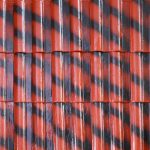
When it comes to building or renovating a house, one of the crucial elements that demand attention is the roofing system. Roofing not only adds aesthetic appeal to a structure but also serves as the primary line of defense against the elements. Among the various roofing materials available, roof tiles have been a popular choice for centuries. But are roof tiles truly waterproof? In this article, we will delve into the world of roof tiles to unveil the truth about their waterproofing capabilities.
1. Understanding Roof Tiles
Before we can determine whether roof tiles are waterproof, it’s essential to comprehend the different types of roof tiles commonly used in construction.
1.1. Ceramic Roof Tiles
Ceramic roof tiles, often recognized for their durability and aesthetic appeal, exhibit low water absorption rates. On average, ceramic tiles have a water absorption rate ranging from 0% to 6%. This means that they can absorb a minimal amount of moisture when exposed to rain or other forms of precipitation. The low water absorption of ceramic tiles contributes to their ability to provide excellent waterproofing when installed correctly.
1.2. Cement Roof Tiles
Cement roof tiles, a popular choice due to their affordability and durability, typically have a higher water absorption rate compared to ceramic tiles. On average, cement tiles can absorb up to 15% of their weight in water. While this absorption rate is higher than that of ceramic tiles, cement tiles are engineered with additives and coatings to minimize water infiltration. Proper installation practices, including overlapping and flashing, play a crucial role in ensuring the waterproofing of cement roofs.
1.3. Clay Roof Tiles
Clay roof tiles, known for their natural appearance and insulation properties, tend to have the highest water absorption rate among roofing materials. On average, clay tiles can absorb up to 25% of their weight in water. While this rate is comparatively higher, clay tiles also rely on proper installation and overlapping techniques to prevent water from penetrating beneath the tiles. Additionally, clay tiles are often designed with improved profiles and coatings to enhance their water resistance.
2. Installation Matters
Regardless of the type of roof tiles used, the key to achieving waterproof roofing lies in the installation process. Roof tiles, whether clay or concrete, are not inherently waterproof by themselves. Instead, their ability to keep water out of your home relies on the installation technique.

2.1 Roof Underlayment
The first line of defense against water infiltration is the roof underlayment. A high-quality underlayment, typically made of asphalt-saturated felt or synthetic materials, is essential. It acts as a secondary barrier to prevent water from seeping through the gaps between tiles.
- Sealing Vulnerable Areas: Underlayment is strategically placed in vulnerable areas, including roof valleys, eaves, and intersections, where water is more likely to penetrate. It acts as a watertight shield in these critical zones.
- Water Shedding: In the event that water does infiltrate the tile surface, underlayment helps redirect moisture away from the roof’s interior. This prevents water from reaching the underlying decking and insulation.
- Protection During Installation: Underlayment safeguards the roofing structure during the tile installation process. It ensures that any temporary water penetration does not harm the underlying components.
2.2 Proper Overlapping
During installation, each row of tiles should overlap the row below it. This overlapping design creates a natural drainage system, channeling rainwater away from vulnerable areas.
2.3 Flashing and Ridge Tiles
Proper flashing installation around roof penetrations like chimneys, vents, and skylights is crucial. Ridge tiles, placed at the peak of the roof, also play a role in preventing water infiltration.
3. Maintenance is Key
Even with the best installation, no roofing system can remain waterproof without regular maintenance.
3.1 Inspection
Regular inspections of your roof are necessary to identify and address any damaged or displaced tiles promptly. Broken or missing tiles can compromise the waterproofing of your roof.
3.2 Cleaning
Keeping your roof clean of debris, moss, and algae growth is vital. These elements can trap moisture and deteriorate the tiles over time.
3.3 Repairs
Promptly repair any damaged tiles or flashing to maintain the integrity of your roof.
CONCLUSION
In conclusion, the extent to which roof tiles are waterproof depends on various factors, including the type of roofing material and proper installation practices. While no roofing material is entirely impermeable, ceramic tiles tend to have the lowest water absorption rates, followed by cement and clay tiles. The key to effective waterproofing lies in selecting the right roofing material for your specific needs and ensuring that it is installed correctly. Regular maintenance and prompt repairs further enhance the long-term waterproofing performance of your roof
NOTABLE MENTIONS :
Understanding Water Absorption
Water absorption in roof tiles refers to the amount of moisture a tile can retain. While some tiles are engineered to be highly water-resistant, none are entirely waterproof. Even tiles marketed as “waterproof” have a certain degree of water absorption, typically measured as a percentage.
This absorption may result in occasional, subtle tints of absorbed water. It’s essential to recognize that these tints are usually barely noticeable and have no significant impact on the functionality or aesthetics of the tiles.

 Facebook
Facebook Twitter
Twitter Google +
Google + Instagram
Instagram Message Me
Message Me




Sampathkumar S says:
Really informative and valuable blog, keep sharing,